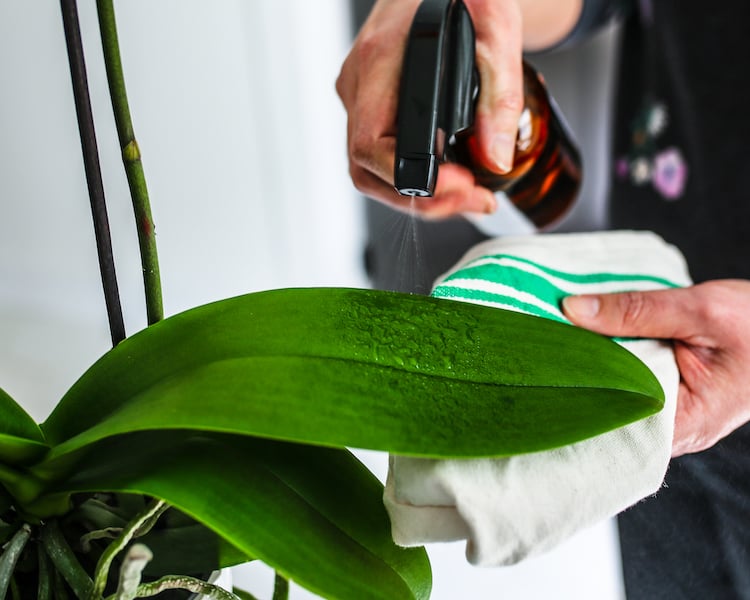
Even though indoor plants are protected from the wild, they still have ‘predators,’ particularly insects and fungus. While you’ll find many solutions on the market, many of them are riddled with noxious chemicals that you and your family – including pets – could end up inhaling.
But don’t worry! We’ve found a few natural ways to keep insects and fungus off your indoor plants. Some of these home remedies have additional benefits for humans too, a win-win!
A simple recipe to keep pesky insects away is to mix 1 teaspoon (5 ml) of neem oil and ½ teaspoon (2.5 ml) of a gentle, plant-safe liquid dish soap to 1 quart (.9 l) of warm water, or 4 teaspoons (20 ml) of neem oil and 2 teaspoons (10 ml) of liquid dish soap to 1 gallon (3.8 l) of water.
A 50:50 solution of isopropyl alcohol and warm water can be substituted for plain water.
Don’t use this oil in temperatures warmer than 85° or in direct sunlight. Apply every week or every two weeks until the problem is under control.
You’ve probably seen Neem oil in natural toothpaste, but it’s also found in beauty products because it is reported to give the skin a healthy glow!
You can find this East Indian staple right around the corner at your Home Depot as well as plenty of online sources. Neem oil has been used since ancient times as an insect and parasite repellent. It’s harmless to humans and to animals and is approved by the US Environmental Protection Agency for use on food crops.
When cinnamon is used on orchids, it inhibits bacteria and fungal growth. As an added bonus, its aromatic scent will also keep your pets from nibbling on your orchids. (Yes, orchids are pet-friendly plants, but you still don’t want your furry friends to destroy them!)
Cut away the infected tissue using a sterilized single-edge razor blade, pruning shears or scissors in addition to an additional inch of clean, green area. Coat the cut area well with cinnamon. Repeat every few days until the problem is controlled.
Be sure to wipe away cinnamon that lands on non-wounded areas as its dehydrating properties can damage sensitive areas of the plant!
In addition to being the go-to spice for desserts, some nutritionists recommend it to control blood sugar levels!
No, you don’t need to get some kind of industrial form of cinnamon to keep bugs and fungus away from your beautiful orchid.
This common household spice found in your supermarket aisle can also deter fungal infections! If your orchid is showing signs of a fungal infection, take swift action as it can spread rapidly, especially in the summer.
This insecticide is actually derived from Chrysanthemum flowers. Don’t let its origin fool you; this ingredient packs quite the punch against pests. When sprayed on insects, pyrethrum shuts down their central nervous systems on contact.
It poses a very low toxic risk for humans and pets and breaks down quickly, leaving no traces after several hours, but it can be harmful when used in conjunction with other toxic materials, like PBO (piperonyl butoxide), which is a synthetic synergist that boosts insect killing strength.
Lightly spraying your plant every few days is a good general rule to help manage your problem. This is especially effective as a preventative or to control light infestations of mites, mealybugs and aphids.
Although pyrethrum creates a powerful insecticide when extracted from chrysanthemums, people have been drinking chrysanthemum tea for a long time. According to WebMD, the flowers have been used to treat medical issues, such as chest pain.
Many people also plant chrysanthemums in the garden to add another line of defense against pests.
You can purchase solutions made with pyrethrum online on sites like Amazon or purchase them in stores like Home Depot.
A native of “The Land Down Under,” this environmentally safe natural pesticide and insecticide is used to combat a wide spectrum of threats ranging from fungi to mites and other insects.
Here’s a DIY oil-based recipe to drown out pesky insects from invading your orchids:
Mix 1 teaspoon (5 ml) of a horticultural oil (neem oil, superfine oils, peppermint or eucalyptus oil), ½ teaspoon (2.5 ml) gentle, plant-safe liquid dish soap into one quart (.9 l) of warm water.
For a larger batch, combine 4 teaspoons (20 ml) horticultural oil, 2 teaspoons (10 ml) of dish soap and 1 gallon (3.8 l) of water.
Shake the solution during use to keep the ingredients well mixed, and make up a fresh batch for each application. Thoroughly coat all surfaces of the plants being treated; the oil smothers insects, so making contact with the pests is essential for the oil to be effective. Note: Recipe originally found through American Orchid Society.
It’s everywhere! You can find this botanical oil through many companies online or in your local health food store.
The Eucalyptus plant has been used as a disinfectant for many years, which is why it’s an ingredient in many natural cleaning products, particularly those designed for the bathroom.
Your orchids are not at the mercy of insects and fungi; you can fight back with natural solutions that will protect your plant from harm and keep your family and pets free from chemicals!
Repeat these treatments every week for maximum insect control. Subscribe to our blog for more orchid care tips and suggestions.

Copyright Just Add Ice® Orchids 2023